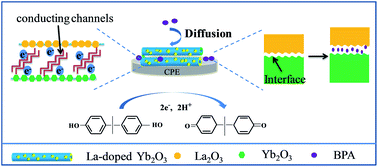Application of a novel endocrine disruptor bisphenol A electrochemical sensor based on analogous heterostructure characteristics of La-doped Yb2O3 nanomaterials
Abstract
Bisphenol A (BPA) is one of the most prevalent environmental endocrine disrupting chemicals. In this present paper, a facile BPA sensor was successfully fabricated based on a La-doped Yb2O3 nanorod modified carbon paste electrode (La–Yb2O3/CPE). La-doped Yb2O3 nanorods were synthesized using a one step hydrothermal synthesis method and further investigated by X-ray diffraction (XRD), scanning electron microscopy (SEM) and energy dispersive X-ray spectroscopy (EDS). Electrochemical impedance spectroscopy (EIS), cyclic voltammetry (CV) and amperometric response analysis were applied to characterize the electrochemical properties of the sensor. Under the optimal conditions, the oxidation current increased linearly with increasing the concentration of BPA in the range of 0.04 to 15 μM with a detection limit of 0.013 μM. The prepared La-doped Yb2O3 nanomaterial modified electrode showed good reproducibility, stability and anti-interference ability. Furthermore, this newly developed sensor was further adopted to measure BPA in tap water and milk samples. The possible electrocatalytic sensing mechanism is discussed.



 Please wait while we load your content...
Please wait while we load your content...